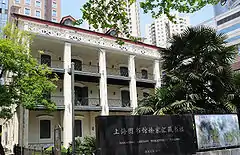Bibliotheca Zi-Ka-Wei
The Shanghai Library Bibliotheca Zi-Ka-Wei (simplified Chinese: 上海图书馆徐家汇藏书楼; traditional Chinese: 上海圖書館徐家匯藏書樓; pinyin: Shànghǎi Túshūguǎn Xújiāhuì Cángshū Lóu), also known as the Bibliotheque de Mission, is the first modern library to be established in Shanghai, China. Located in the Xujiahui area in Xuhui District,[1] it first opened in 1847.[2] It is a part of the Shanghai Library system.[3]
 | |
| Country | China |
|---|---|
| Established | 1847 |
| Location | Shanghai |
| Map | |

| |
History
The Xujiahui Library began with the arrival of three Jesuit missionaries in 1842: Frs. Claude Gotteland (1803-1856), the head of the mission, Francois Esteve (1804-1848), and Benjamin Brueyre (1808-1880).[4] As the missionary work progressed over the next five years, it became clear that a permanent place of residence was needed, in part to provide a place for newly arrived missionaries to study Chinese and prepare for their work. The site chosen was the village of Xujiahui (pronounced Zikawei in Shanghainese), five miles southwest of Shanghai, although the area has since been annexed into Shanghai municipality. Fr. Gotteland also made the decision to set aside space for a collection of books supporting the missionaries' study and work upon their arrival at Xujiahui. It was from these modest beginnings that the Xujiahui Library (Zikawei Library), which would become one of the two foremost Jesuit libraries in China (the other being the Beitang Library), was established in 1847.[4]
The library was originally housed in three rooms in the mission priests' quarters on the north side of the existing chapel. Then in 1860, the Jesuits added to their land holdings in Xujiahui, and the library was moved east of the Zhaojiabang Canal and that building was enlarged. By 1897 the library's holdings had once again outgrown the space. Plans were drawn up for a new two-story, twelve-room library, which was completed in 1906. This new library building was divided into a Chinese style first floor area for materials in Chinese and a Western language section on the second floor.[4] This library was referred to by several names, known from the stamps of ownership inside the books in the library. These names included Zi-ka-wei Reservata Bibliotheca, Bibliotheca Zi-ka-wei, Zi-ka-wei Bibliotheque de Mission, Zi-ka-wei Bibliotheca Major, and in Chinese, Shanghai Xujiahui Tianzhutang Cangshulou ("Library of the Catholic Church of Xujiahui, Shanghai"). Local people in the area called the big building among the old ginkgo trees simply "The Great Library."[4]
At its height, the Xujiahui Library collection included over 100,000 titles in 200,000 volumes: 80,000 volumes in European languages and 120,000 volumes in Chinese.[4] After the destruction of the Oriental Library (Dongfang Tushuguan) in 1932 by Japanese militarists,[5][6] it was the largest library in Shanghai. Besides its extensive holdings of gazetteers, the Xujiahui Library also held early, rare newspapers and magazines. The European language collection of the Xujiahui Library was made up of books in over ten different languages, including Hebrew, Latin, Greek, and other European languages. The library owned major dictionaries and encyclopedias from all over the world and important scholarly journals to aid the Jesuits in their studies, as well as over two thousand pre-1800 rare editions.[4]
It became a branch of the Shanghai Library system in 1956 and was renovated in 2003.[7]
References
- Titangos, Hui-Lan H. (2016). "Xujiahui Library: A Cultural Crossroads between East and West" (PDF). Chinese Librarianship. 41.
- Ciric, Biljana (6 June 2016). "Building archives through curatorial practice". Art Libraries Journal. 39 (02): 10–13. doi:10.1017/S0307472200018253.
the Bibliotheca Zi Ka Wei, built in 1847
- Wu, Min (2008). Newspapers in the Shanghai Library." International Newspaper Librarianship for the 21st Century. Walter de Gruyter. ISBN 9783598440205.
The older foreign newspaper reading room is located in the Bibliotheca Zi-Ka-Wei, a branch of the Shanghai Library.
- King, Gail. (1997). "The Xujiahui (Zikawei) Library of Shanghai." Libraries & Culture, 32(4), (Fall, 1997), pp. 456-469, University of Texas Press. - Available on JSTOR.
- Board of Directors of the Oriental Library, A Description of the Oriental Library Before and After the Destruction by Japanese on February 1, 1932, Shanghai: Mercury Press, 1932, p. 5. Retrieved 15 August 2020.
- Michael R. Godley, Review of The Life and Times of Zhang Yuanji, 1867-1959 by Manying Ip, in: Australian Journal of Chinese Affairs, No. 19/20 (Jan. - Jul., 1988), p. 416. Retrieved 15 August 2020.
- "The Bibliotheca Zi-Ka-Wei (The Xujiahui Library)" (Archive). Shanghai Library. Retrieved on September 16, 2015.
Notes
Some material originates from Shanghai Library.
External links
| Wikimedia Commons has media related to Xujiahui Library. |